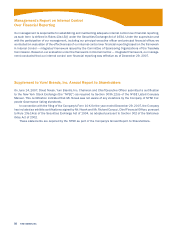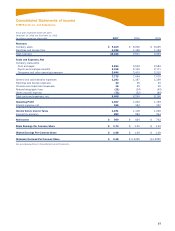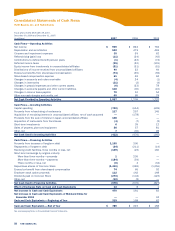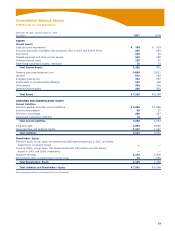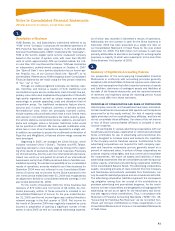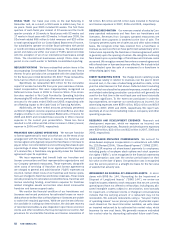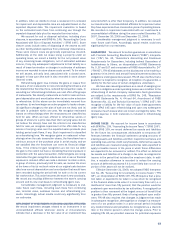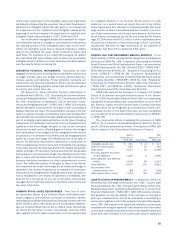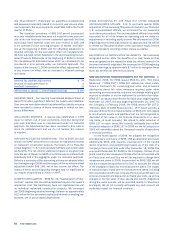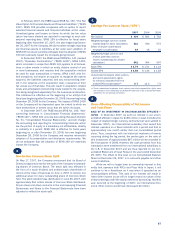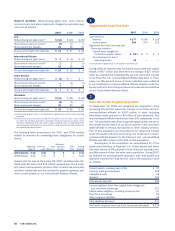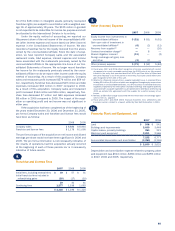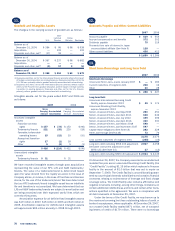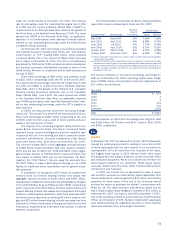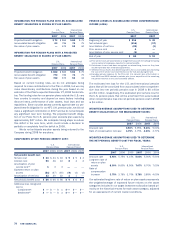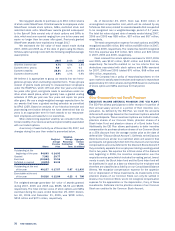Pizza Hut 2007 Annual Report Download - page 62
Download and view the complete annual report
Please find page 62 of the 2007 Pizza Hut annual report below. You can navigate through the pages in the report by either clicking on the pages listed below, or by using the keyword search tool below to find specific information within the annual report.
66 YUM! BRANDS, INC.
(the “Dual Method”). Historically, we quantified misstatements
and assessed materiality based on a current year income state-
ment approach. We were required to adopt SAB 108 in the fourth
quarter of 2006.
The transition provisions of SAB 108 permit uncorrected
prior year misstatements that were not material to any prior peri-
ods under our historical income statement approach but that
would have been material under the dual method of SAB 108
to be corrected in the carrying amounts of assets and liabili-
ties at the beginning of 2006 with the offsetting adjustment to
retained earnings for the cumulative effect of misstatements.
We have adjusted certain balances in the accompanying Consoli-
dated Financial Statements at the beginning of 2006 to correct
the misstatements discussed below which we considered to be
immaterial in prior periods under our historical approach. The
impact of the January 1, 2006 cumulative effect adjustment, net
of any income tax effect, was an increase to retained earnings
as follows:
Deferred Tax Liabilities Adjustments $ 79
Reversal of Unallocated Reserve 6
Non-GAAP Conventions 15
Net Increase to January 1, 2006 Retained Earnings $ 100
DEFERRED TAXES Our opening Consolidated Balance Sheet at
Spin-off included significant deferred tax assets and liabilities.
Over time we have determined that deferred tax liability amounts
were recorded in excess of those necessary to reflect our tem-
porary differences.
UNALLOCATED RESERVES A reserve was established in 1999
equal to certain out of year corrections recorded during that
year such that there was no misstatement under our historical
approach. No adjustments have been recorded to this reserve
since its establishment and we do not believe the reserve
is required.
NON-GAAP ACCOUNTING CONVENTIONS Prior to 2006, we used
certain non-GAAP conventions to account for capitalized interest
on restaurant construction projects, the leases of our Pizza Hut
United Kingdom (“U.K.”) unconsolidated affiliate and certain state
tax benefits. The net income statement impact on any given year
from the use of these non-GAAP conventions was immaterial both
individually and in the aggregate under our historical approach.
Below is a summary of the accounting policies we adopted effec-
tive the beginning of 2006 and the impact of the cumulative effect
adjustment under SAB 108, net of any income tax effect. The
impact of these accounting policy changes was not significant to
our results of operations in 2006 or 2007.
INTEREST CAPITALIZATION SFAS No. 34, “Capitalization of Inter-
est Cost” requires that interest be capitalized as part of an asset’s
acquisition cost. We traditionally have not capitalized interest
on individual restaurant construction projects. We increased
our 2006 beginning retained earnings balance by approximately
$12 million for the estimated capitalized interest on existing res-
taurants, net of accumulated depreciation.
LEASE ACCOUNTING BY OUR PIZZA HUT UNITED KINGDOM
UNCONSOLIDATED AFFILIATE Prior to our fourth quarter 2006
acquisition of the remaining fifty percent interest in our Pizza Hut
U.K. unconsolidated affiliate, we accounted for our ownership
under the equity method. The unconsolidated affiliate historically
accounted for all of its leases as operating and we made no
adjustments in recording equity income. We decreased our 2006
beginning retained earnings balance by approximately $4 million
to reflect our fifty percent share of the cumulative equity income
impact of properly recording certain leases as capital.
RECOGNITION OF CERTAIN STATE TAX BENEFITS We historically
recognized certain state tax benefits on a cash basis as they
were recognized on the respective state tax returns instead of in
the year the benefit originated. We increased our 2006 beginning
retained earnings by approximately $7 million to recognize these
state tax benefits as deferred tax assets.
NEW ACCOUNTING PRONOUNCEMENTS NOT YET ADOPTED In
September 2006, the FASB issued SFAS No. 157, “Fair Value
Measures” (“SFAS 157”). SFAS 157 defines fair value, estab-
lishes a framework for measuring fair value and enhances
disclosures about fair value measures required under other
accounting pronouncements, but does not change existing guid-
ance as to whether or not an instrument is carried at fair value.
SFAS 157, as issued, was effective for fiscal years beginning after
November 15, 2007, the year beginning December 30, 2007 for
the Company. In February 2008, the FASB issued FSP 157-2,
“Effective Date of FASB Statement No. 157” which permits a
one-year deferral for the implementation of SFAS 157 with regard
to non-financial assets and liabilities that are not recognized or
disclosed at fair value in the financial statements on a recur-
ring basis (at least annually). We intend to defer adoption of
SFAS 157 for such items. We currently anticipate that neither
the partial adoption of SFAS 157 in 2008 nor the full adoption in
2009 will materially impact the Company’s results of operations
or financial condition.
In the fourth quarter of 2006, we adopted the recognition
and disclosure provisions of SFAS 158 as described previously.
Additionally, SFAS 158 requires measurement of the funded
status of pension and postretirement plans as of the date of a
company’s fiscal year that ends after December 15, 2008 (the
year ended December 27, 2008 for the Company). Certain of our
plans currently have measurement dates that do not coincide with
our fiscal year end and thus we will be required to change their
measurement dates in 2008. As permitted by SFAS 158, we will
use the measurements performed in 2007 to estimate the effects
of our changes to fiscal year end measurement dates. The impact
of transitioning to fiscal year end measurement dates, including
the net periodic benefit cost computed for the period between our
previous measurement dates and our fiscal year ends, as well as
changes in the fair value of plan assets and benefit obligations
during the same periods, will be recorded directly to Sharehold-
ers’ Equity. We do not currently anticipate any such amount will
materially impact our financial condition.


